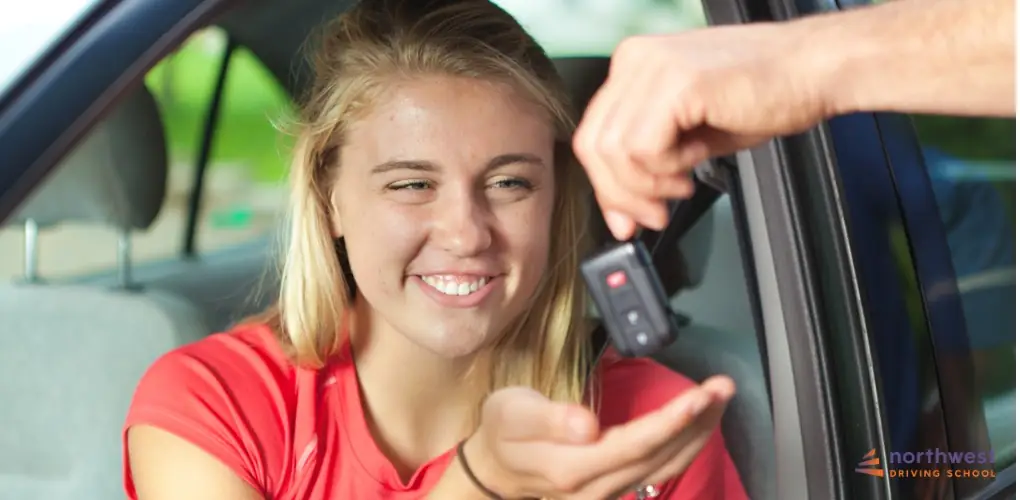- Driving School
Driving at 17: A Comprehensive Guide for New Drivers and Parents

For many teenagers, turning 17 heralds is an important milestone. It’s the age at which they can legally take to the road independently.
However, before they shift gears, there’s a complex set of road rules, both legal and practical, that demand their attention. This comprehensive guide is designed to accompany 17-year-olds and their parents on their educational journey about the intricacies of driving at a pivotal age.
Read More: Tips For Teen Drivers
Table of Contents
Can 17-Year-Olds Drive?
At 17, the world opens with new horizons, such as acquiring a driver’s license. However, the legal prerequisites for obtaining this license vary considerably across states and regions.
In Nevada, for example, getting a license at this age is a straightforward process that involves applying for the license at 16, passing a written test, and completing 50 hours of practice driving. The Nevada DMV also requires you to:
- Hold a valid instruction permit for at least six months before applying
- Have no at-fault crashes in the six months before applying
- Have no moving violation convictions in the six months before applying
- Have no alcohol or drug convictions of any kind in the six months before applying
Driving with Passengers
Under Nevada law, “Young drivers may not transport any passenger under 18, except for immediate family members, for the first six months after the license was issued.” This law is an important safety measure to keep teens focused on the road and reduce distractions.
Safety considerations when driving with passengers
Once the six-month probation period has passed, it’s permissible to transport as many passengers as the car can safely accommodate. However, new drivers and parents must understand the potential risks of driving with passengers.
- Distractions: Passengers, especially friends, can be a source of distraction for new drivers. They may engage in conversations or activities that divert the driver’s attention from the road.
- Peer pressure: With friends in the car, new drivers may feel more pressure to take risks or show off their driving skills, leading to dangerous maneuvers or speeding.
- Noise level: Passengers can create a loud and chaotic environment in the vehicle, making it difficult for the driver to focus on the road and hear essential sounds like sirens or horns.
- Increased risk of accidents: Studies have shown that the presence of passengers in a car increases the risk of accidents for teen drivers. Inexperience and distractions from passengers can lead to poor decision-making and driving reactions.
Driving Alone
You can drive alone once you have passed your test and obtained your license. This newfound freedom is exciting but comes with a great responsibility. It’s crucial to remember that driving alone means being solely responsible for your safety and the safety of others on the road.
Tips for safe solo driving
- Limit distractions: Avoid using your phone or engaging in activities that take your focus away from driving.
- Know your route: Plan your route and have a general idea of the directions to avoid getting lost or distracted while driving.
- Follow traffic rules: Obey speed limits, traffic signals, and road signs to ensure safe driving.
- Maintain your vehicle: Regularly check the condition of your car, including tire pressure, brakes, and lights. This will help prevent breakdowns or accidents caused by vehicle malfunctions.
- Watch out for other drivers: Be aware of other vehicles on the road, anticipate their movements, and always be prepared to react quickly if needed.
Curfews for Teenage Drivers
Drivers under 18 in Nevada may only drive between 10 p.m. and 5 a.m. if traveling to or from a scheduled event, such as school or work. Nighttime driving presents additional challenges and hazards, making it essential for new drivers to develop good habits and skills for safe driving in the dark.
Tips for safe nighttime driving
- Ensure clear visibility: Ensure all your vehicle lights function correctly, and clean your windshield regularly to avoid glare from oncoming headlights.
- Reduce speed: Seeing pedestrians, animals, and other hazards at night is more challenging. Slow down to give yourself more time to react.
- Avoid drowsy driving: Nighttime driving can be tiring, so ensure you are well-rested before getting behind the wheel.
- Stay alert: Avoid distractions and stay vigilant for any unexpected dangers on the road. Be particularly cautious in areas with low visibility or high animal populations.
Statistics and Trends
According to NHTSA, motor vehicle crashes are the leading cause of death for teenagers in the United States. Understanding the risks and factors contributing to these statistics is crucial.
Factors contributing to teenage accidents
- Inexperience: New drivers need more experience on the road, making them more susceptible to accidents.
- Distractions: Texting, using social media, and interacting with passengers while driving are common distractions for teenage drivers.
- Speeding: Teenagers are more likely to speed than adult drivers due to factors like peer pressure and overconfidence.
- Late-night driving: Fatigue and limited visibility make nighttime driving a significant risk factor for teenage accidents.
Trends in Teenage Driving
- Graduated licensing: Many states, including Nevada, have implemented graduated licensing systems to gradually introduce young drivers to the road and limit their exposure to high-risk situations.
- Advanced safety features: Technological advancements in vehicles, such as lane departure warning and automatic emergency braking, have helped reduce accidents among teenage drivers. Parents can also install aftermarket tools like speed alert devices to monitor their teen’s driving behavior.
- Education and parental involvement: Programs that educate teenage drivers on safe driving practices and involve parents in learning have shown positive results in reducing accidents.
Driver’s License Requirements for 17-Year-Olds
In Nevada, 17-year-olds can apply for a driver’s license after completing a driver’s education course. These requirements ensure that young drivers have received proper training and guidance before obtaining their licenses, increasing road safety for both the driver and others on the road.
Benefits of driver education courses
- Hands-on experience: Driver education courses often include behind-the-wheel instruction, allowing teenagers to gain practical driving experience in a safe, controlled environment.
- Understanding of traffic laws: These courses teach young drivers about traffic laws, rules of the road, and defensive driving techniques, promoting responsible and informed driving behavior.
- Awareness of dangers: Driver education courses also educate teenagers on the risks associated with distracted and reckless driving, increasing their awareness and understanding of the consequences of their actions.
Car Insurance for 17-Year-Olds
As a new driver, it’s essential to understand the importance of car insurance and the type of coverage you need. While it may seem unnecessary, having proper insurance can protect you financially in case of an accident.
The average cost for teenage male drivers is $4,200 for a 16-year-old, $3,877 for a 17-year-old, $3,607 for an 18-year-old, and $3,219 for a 19-year-old, according to 2022 CarInsurance.com data
Types of car insurance coverage
- Liability coverage pays for damages or injuries caused by you in an accident.
- Collision coverage pays for damages to your car in an accident, regardless of who is at fault.
- Comprehensive coverage covers damages to your car caused by non-collision events, such as theft or natural disasters.
Tips for obtaining affordable car insurance
- Good student discounts: Many insurance companies offer discounts to students with good grades. Keep up your grades to lower your insurance costs.
- Safe driving discounts: Maintaining a clean driving record can lower insurance premiums.
- Consider adding yourself to your parents’ policy: Adding yourself as an additional driver on your parent’s car insurance can often be cheaper than getting your policy. However, make sure you are listed as the primary driver of the vehicle you will be using.
Choosing the Right First Car
Choosing the right car is crucial for your safety and budget as a teenage driver. Here are some factors to consider when looking for your first car:
- Safety features: Look for cars with advanced safety features like lane departure warning, automatic emergency braking, and blind-spot detection.
- Size and weight: Heavier vehicles may be safer in an accident compared to smaller ones. Consider this factor when choosing a car.
- Reliability and maintenance costs: Research the reliability of different car models and consider potential maintenance costs before purchasing.
- Insurance rates: Certain cars, such as sports cars, are more expensive to insure due to their higher risk of accidents. Consider the insurance rates for your chosen vehicle before making a decision.
Prioritizing Safety and Responsibility
Recognizing the risks and challenges inherent in driving at 17 is the first step towards cultivating a culture of safety and responsibility. It’s not just about abiding by laws and regulations—although these are important—it’s about developing instincts for defensive driving, learning to recognize hazards, and always being prepared for the unexpected.
Supercharging Your Driving Journey
While the rules that come with driving at 17 may seem stringent, they are designed with good intentions. The objective is not to diminish the excitement of this newfound liberty but to orient new drivers toward safety and preparedness. Staying informed and remaining attentive to the core driving responsibilities is paramount for a secure and rewarding experience on the road.
Northwest Driving School’s comprehensive driver education program teaches you the essential skills and knowledge to become a responsible and confident driver. Our experienced instructors provide hands-on training in a friendly and supportive environment, preparing you for a safe driving journey ahead. Contact us today at (702) 212-5667 to learn more about our programs and enroll in your first driving lesson!

